This blog post is basically the TL;DR version of this webinar and whitepaper created, sponsored, and hosted by Bing, iProspect, and AdWeek. I reimagined it and added my own perspective with the goal of creating an educational resource for my team and our clients.
Marketing is all about connection points. It’s about reaching your target audience during the many digital touchpoints that influence their final decision on where and how to spend their money.
Up until recently, the number of these touchpoints was increasing. For example, let's say you need sunglasses—so you research polarization on your phone. You then research local brands on your tablet. Next, you search for sales on your laptop. Finally, you circle back to this task in a week and purchase a pair of sunglasses from your laptop.
But with the adoption of voice search, the number of touchpoints for many transactions like these will shrink.
Successful brands will be those that place this new consumer behavior and intent at the core of their strategies, with a focus on the value they can deliver to the individual.
What is a Digital Assistant?
"A digital assistant is a computer program leveraging artificial intelligence that can understand a variety of inputs (text, voice, data) in order to answer questions and carry out tasks for an individual." (Bing & iProspect, 2017)
Answering questions about the weather, directions, facts, calendar reminders, shopping lists, and more—these were the initial features provided by digital assistants. However, the real power recently realized by digital assistants is their ability to take action at a your request, and eventually acting in anticipation of your needs.
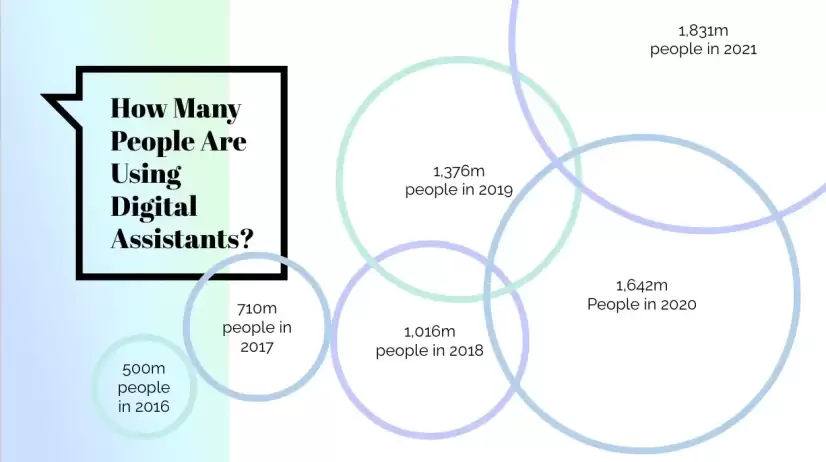
Today, over 500 million people use a digital assistant of some kind. That number is expected to increase to over 1.8 billion people by 2021 (Tractica, 2016). That number reflects almost every person living in the developed world.
Types of Digital Assistants
Smartphone Operating System
- Cortana for Windows 10 Mobile
- Google Assistant for Android
- Apple Siri for iOS
Smartphone Mobile App
- Cortana app for Android and iPhone
- Google app for iPhone
Desktop Computer
- Cortana for Windows 10
- Siri for MacOS Sierra
Smart Home Hub
- Amazon Echo
- Google Home
- Apple HomePod
- Harman Kardon Cortana
The one common thread between all types of digital assistants is that they function using highly evolved search engines powered by voice recognition and intelligence—enabling meaningful, ongoing interactions with users.
Digital Assistants Use by Platform (in Millions)
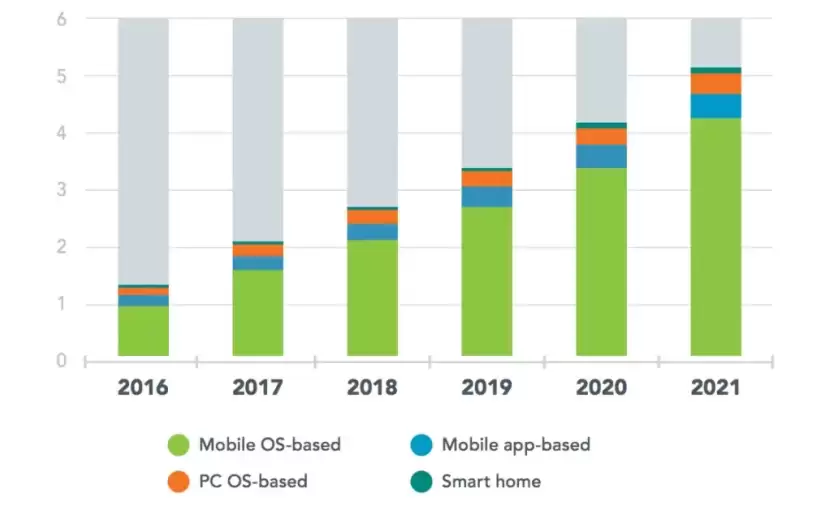
Mobile assistants (the ones that come as a part of your phone's operating system or as an app download) have a clear adoption advantage due to today's mobile behavior—people always have their phone with them, so why not use the digital assistant that's already in your pocket?
Mobile OS-based assistants, the programs that come pre-installed on a smartphone and are fully integrated into the phone’s operating system, provide a greater range of features than app-based assistants. While digital assistant apps often have reduced functionality, namely the fact that you must open an app to use it instead of just speaking to your phone at any time, assistant apps allow users to install a different assistant on their device. For example, an iPhone user might prefer Google Assistant.
Despite the buzz around smart home hubs like Amazon Echo and Google Home, these devices actually represent the smallest piece of the digital assistant right now.
Millennials Aren't the Only Ones Using Digital Assistants
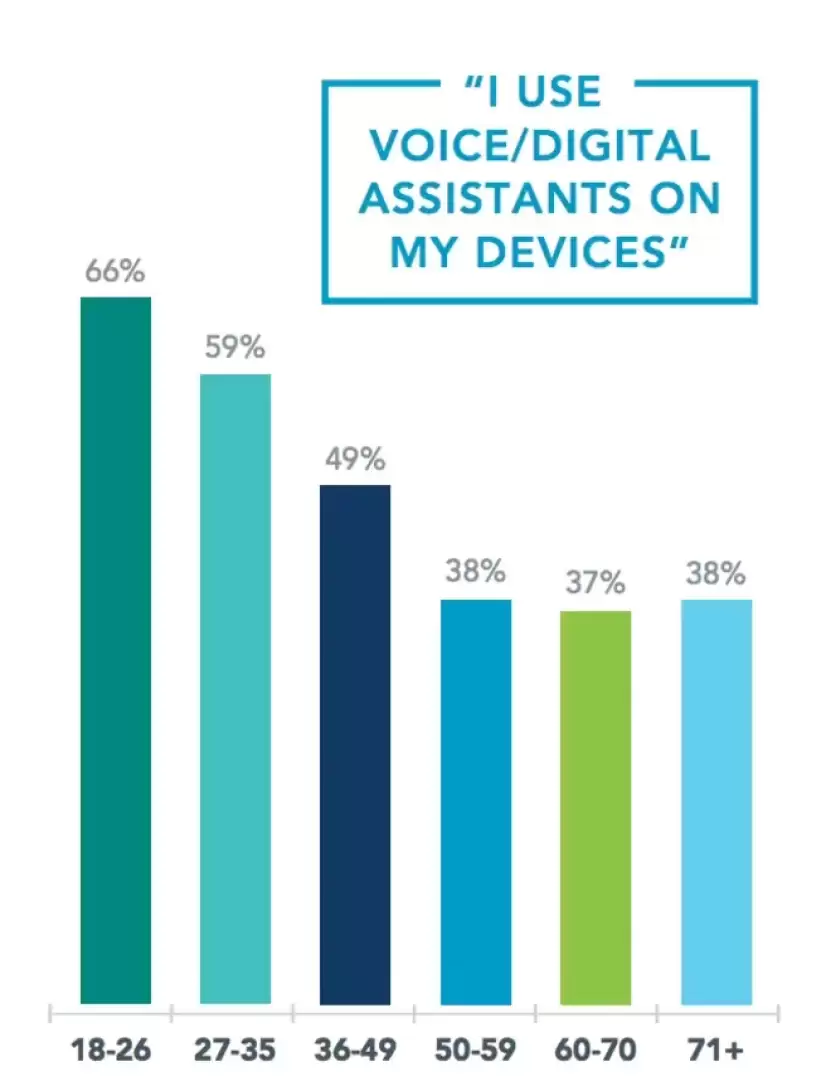
Why are users integrating digital assistants into their lives, and what considerations will increase adoption?
Decreased Digital Overload
The average smartphone user has over 33 apps on their phone, but 80% of their screen time is spent in just three of them. Over 70 million people used adblockers this year on their devices—an increase of 34% from the previous year—because “the ads were irrelevant and intrusive.” People want to use technology on their own terms more than ever. Digital assistants allow for this by providing one cross-device entry point to their digital lives. From quick answers to ordering an Uber, digital assistants make it easy to accomplish a variety of tasks without interruption or delay caused by ads or having to switch between apps or devices.Hyper-Personalization
Consumers now expect heightened levels of personalization as they research and transact. More than 70% of consumers expect a personalized experience when interacting with brands. Today’s consumers have come to expect hyper-personalized and targeted ads, if ads must be tolerated at all. They expect help to expedite mundane tasks like completing forms and even with providing credit card information for payments. They expect immediate assistance from brands' support channels regardless of call volume or standard business hours. Consumers are willingly sharing more and more personal data in exchange for a more easy, convenient way of life.Improved Word Error Rates
Early voice recognition left a lot to be desired. It was often inaccurate and unreliable, which delayed adoption of very early digital assistant adoption. Just last year however, Microsoft researchers achieved human parity in Word Error Rate (WER) for natural language processing. This improved WER rate has greatly enhanced the digital assistant user experience, allowing even the “technology-challenged” to use digital assistants and other internet services previously daunting to this demographic. As WER continues to improve in accuracy, conversations with digital assistants will only become more enjoyable and feel more natural, which encourages users to use them more frequently for more tasks.Contextual Understanding
When word error rate is no longer a limiting factor, developers will start to focus more on teaching digital assistants to understand contextual meaning behind questions so they are empowered to respond successfully to follow-up questions. For instance, if a user asks Google Assistant, “How far is it to Richmond from Charlottesville?” and then follows up by asking, “What 5-star AirBnBs have availability Thursday through Saturday?” the assistant will recognize the context of location based on the previous question. Perfecting the technology that understands what is being said, combined with continuous improvements to contextual meaning, means that using a digital assistant is not a series of one-off searches—it can be an ongoing conversation that users will want to engage in more frequently and for more complex tasks.Simplified Path to Purchase
Digital assistants can also allow consumers to buy items quickly and easily using only their voice. This behavioral shift actually began a while back with the introduction of subscription services with eCommerce retailers like Amazon. Recently, Amazon made it even easier for consumers to reorder common items with a literal click of a button by introducing "Dash buttons". This feature makes it surprisingly simple to order household goods (I can’t tell you how many times I’ve fat fingered a 35 pound bag of cat litter to my door). Smart home speakers also create a new, easy way for individuals to restock everyday items. Progressive brands are capitalizing on this behavior by building integrations with smart home speakers called "skills". Starbucks recently released a skill for the Amazon Alexa that allows customers to order their favorite drink before visiting a shop by saying, “Alexa, order my Starbucks.” Consumers will eventually expect these superior, easier ways to shop—especially for low cost goods they buy frequently, which don't need to be researched before they are purchased.Relevance
The only reason a consumer will adopt the usage of a digital assistant, or any new technology for that matter, is because it is relevant to their life and daily rhythm. Offering users relevance is no longer a benefit—it's a barrier to entry. For example, if your ad or content on a certain channel is not relevant today, it is not efficient. If and when ads are enabled on digital assistants or new channels in the future, if your ad is not relevant, it will not be served to your audience at all because they will abandon the platform. Although the use of digital assistants is growing, the technology is young and the space is competitive. Digital assistant services are currently focused on gaining adoption, so the technology, above all else, has to be useful, helpful, and provide real value—it must be relevant. Because of this, digital assistant providers are very cautious about monetizing the experience right away. A single disruptive ad or poor experience could cost them a user.
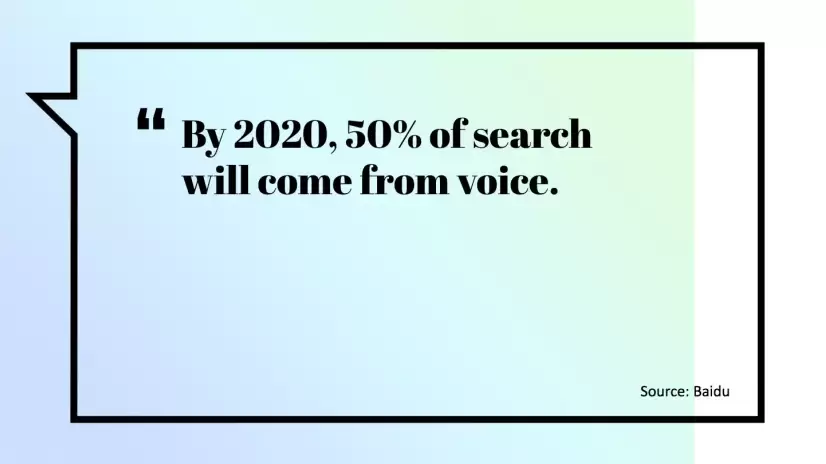
What are some things we can do now to optimize for voice search?
Local and Mobile
As of 2015, the number of mobile queries made through Google officially outnumbered desktop queries. Since voice queries are most often conducted on mobile devices, strategies to capture these searches must be built around local and mobile search intent.
Correct Listings
In order to stay mobile-friendly, brands must update and manage local business listings to ensure their addresses, phone numbers, and business hours are accurate. This includes third-party listings on Yelp, TripAdvisor, and Angie’s List.
Calls-to-Action
In your listings, use strong CTAs like"Call Now", "Get Directions", or "Make Reservations". When possible, businesses should leverage site extensions to enable searchers to take action directly within the SERPs.
Local searchers are on-the-go and looking to take action immediately. Brands must provide the shortest possible path from online interaction to instore purchase to succeed.
Keyword Targeting
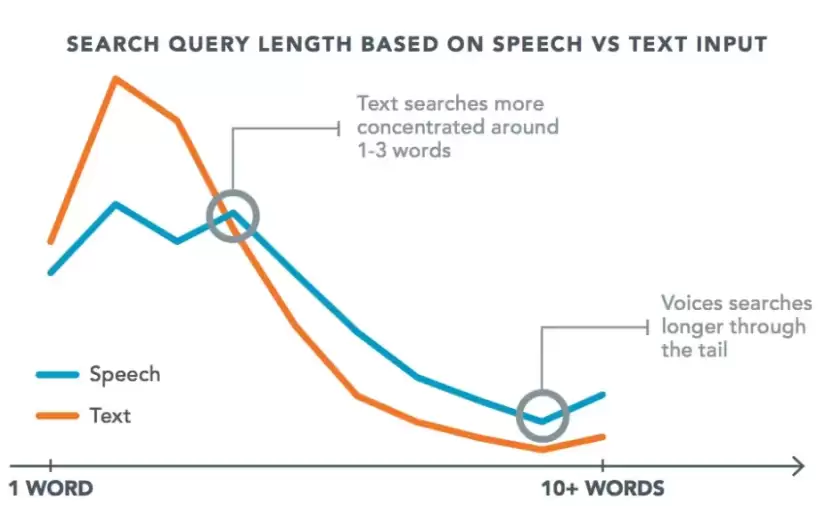
Search engines don't currently allow you to target voice search interactions separately from typed searches. So for now, in order to target voice searchers, we need to target content to longer, more conversational, question-based keywords. Microsoft data shows that voice searches are usually longer than text searches and have a much higher distribution of search volume through the longest (long-tail) keywords.
Use this information to better target voice searches by including question words in your paid keywords and site content like who, what, when, where, why and how. For example, your keywords for targeting digital assistant users shouldn’t be “puff pastry” or “toddler clothing”, they should be “how do I make puff pastry” or “how do I layer toddler clothing in the winter”.
Brands should build content using questions and answers about their products and services. For example, my team recently helped optimize a major social media platform's support site, and if they had a page that titled “managing password” we updated it to “how to change my twitter password”, which makes that answer more likely to be chosen by a digital assistant when a consumer asks that question.
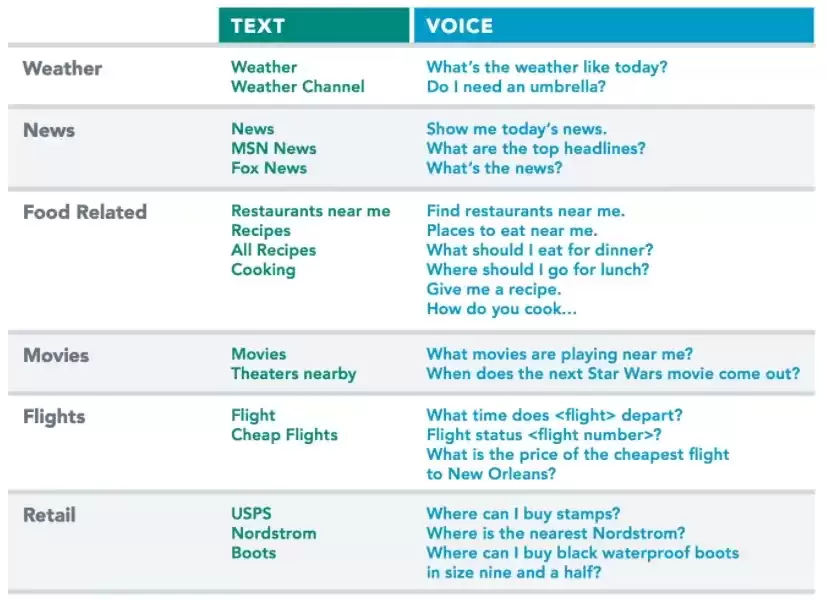
Structured Data
Structured data will likely make it easier for search engines to find answers to user's voice queries.
For example, if a user asks their digital assistant for the nearest Chinese restaurant or the cheapest place to buy a lawn mower, the digital assistant can use structured local and product data to answer the question.
What Next?
Here are some related areas that digital marketers will need to think about in the future:
Bots
Bye, Humans.
Some brands have already invested in and built bots to provide customer service, answer questions, or promote products. According to Garner, customers will manage 85% of their relationship with an enterprise without interacting with a human by the year 2020.
Today’s bots already far exceed human ability and can delight customers with exceptional experiences not just in initial service transactions, but throughout each stage of a customer decision journey. For example, Zulily and 1-800-Flowers are already using the integration of Facebook’s chatbot to communicate with consumers, and some Japanese banks have receptionist bots.
In the future, bots will allow digital assistants to take action on a consumer’s behalf. So after a consumer gets an answer from their digital assistant, bots will be how the digital assistant takes the next step in the consumer journey.
Skills
Digital Assistants Got ‘Em.
“Skills” are the equivalent of third-party apps. Through skills, companies can connect with smart home hubs, like Amazon Echo and the upcoming Harman Kardon Cortana speaker, to reach customers using voice technology to accomplish tasks from their home. Since third-party developers can continuously teach Alexa, Google Home, and others new skills, these devices become more useful the longer you own them.
Companies across all sectors are already building skills, such as Capital One, FedEx, Dominos Pizza, Uber and Starbucks. 1-800-FLOWERS successfully released an Alexa skill just in time for Mother’s Day this year. By connecting to a user’s 1-800-FLOWERS account, customers were able to order a fresh bouquet for mom entirely by voice.
Have you already integrated strategies to capture voice searches and digital assistant adoption into your marketing plan? We'd love to hear from you in the comments! Again, here is the webinar and whitepaper created, sponsored, and hosted by Bing, iProspect, and AdWeek if you'd like to read further.
